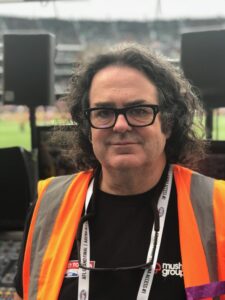News
7 Nov 2017
AFL 2017 Grand Final with JPJ Audio
Subscribe to CX E-News

JPJ Audio took over designing and operating the audio system for the AFL Grand Final entertainment six years ago and it’s been smooth sailing ever since. This year The Killers absolutely nailed it with an incredible performance that won them universal praise.
For sound designer James ‘Oysters’ Kilpatrick the biggest hurdle is the sheer size of the playing field, which is around 500 metres in circumference, and the fact that everything has to be set up in matter of minutes. Of course, it also has to be taken down in an equally short amount of time.
“We do a rehearsal during the week where it all has to be wheeled out and struck down afterwards, and then we do a soundcheck and out it all goes again,” said Oysters. “We also have a large amount of outputs as we’re driving the TV OB for the music, sending a mix with ambient mics to Triple M plus feeding the ground and the media. It takes us about a week to wire and thoroughly check all of the outputs as there are so many including various mix minus feeds.”
Oysters ran an Avid Profile mainly because he wanted stability and the Waves Plugins to run without the complication of a server but also because of its’ small footprint as space is premium. He also required a console that was capable of running ProTools whilst at the same time, could add markers for memories via snapshots, as the rehearsals are recorded on the Thursday and on the Friday there are more rehearsals running everything off the ProTools to the broadcast truck. The reliability of the Avid Profile was also a major factor in its choice especially as the weather and temperature can be quite erratic in Melbourne at that time of year.
At FOH control with Oysters this year were Tim Millikan and Ryan Fallis, with Oysters sending his outputs to Tim to distribute via matrix mixers, line drivers and active splitters. Everything that Oysters had on his console was mirrored onto Tim’s DiGiCo SD11 in case Oysters console was to fail. Ryan looked after the fully redundant ProTools replay and would also send everything he was doing to Channel 7. All control gear was on a UPS and were all timed, with JPJ doing extensive power failure tests in the factory leading up to the event.
“It was all fibre with Channel 7 directly to me so that was a bit easier than years previously,” added Oysters. “Tim and Bowden Birkett (JPJ Audio’s head system engineer) could actually change any part of the PA or any part of the zoning, or even the levels to Channel 7 without asking me.”
It’s important to remember that this is a TV show, not a concert, which can be a hard thing for people to get their head around. It’s not only live in the ground, its going live to millions people, there is no waiting till somebody is ready, it just rolls ready or not.
“You have to use wind socks as it’s our windiest month in Melbourne and it really swirls around the ground,” said Oysters. “RF can also be a problem and in the past, it has failed. This year Frontier production bought in Peter Cochrane from ARTICULATE Communications to manage all of the RF and communications. He lowered the power on all of the radios, allotted all of the frequencies and it worked incredibly well. Everyone is on in-ears because without them the amount of slap back in the playing field is disorientating.”
Sixteen carts of d&b audiotechnik cabinets were wheeled out, each cart holding three d&b J Series cabinets.
“The ground runs in mono with redundant loops of signal and power so the most you could lose would be two or three carts,” said Oysters. “We can even broadcast for about 15 to 20 minutes without power although the speakers would fail. We could have run it with fibre but that would have got quite complex and I try to keep it as simple as possible, especially as so many complex things have failed at this event in the past. Eventually it will be entirely networked but when we do that, we’ll probably run it in the shop for a month before.”
Oysters remarked that this years’ show by The Killers was the best yet, even though the band was so complex he didn’t take a full split of all of their gear.
“As they have so many electronics such as sequencers, synthesizers and keyboards, we had that all bussed down a series of stems by Marty Beath,” he explained. “We took the vocals, guitars and drums all separate but it was condensed across sixteen lines instead of say fifty-six.”
Once the footy had finished, The Killers performed a free show for anyone who wished to attend reverting back to a normal concert set up with FOH and monitors and with Oysters looking after OB to television only.
Subscribe
Published monthly since 1991, our famous AV industry magazine is free for download or pay for print. Subscribers also receive CX News, our free weekly email with the latest industry news and jobs.







